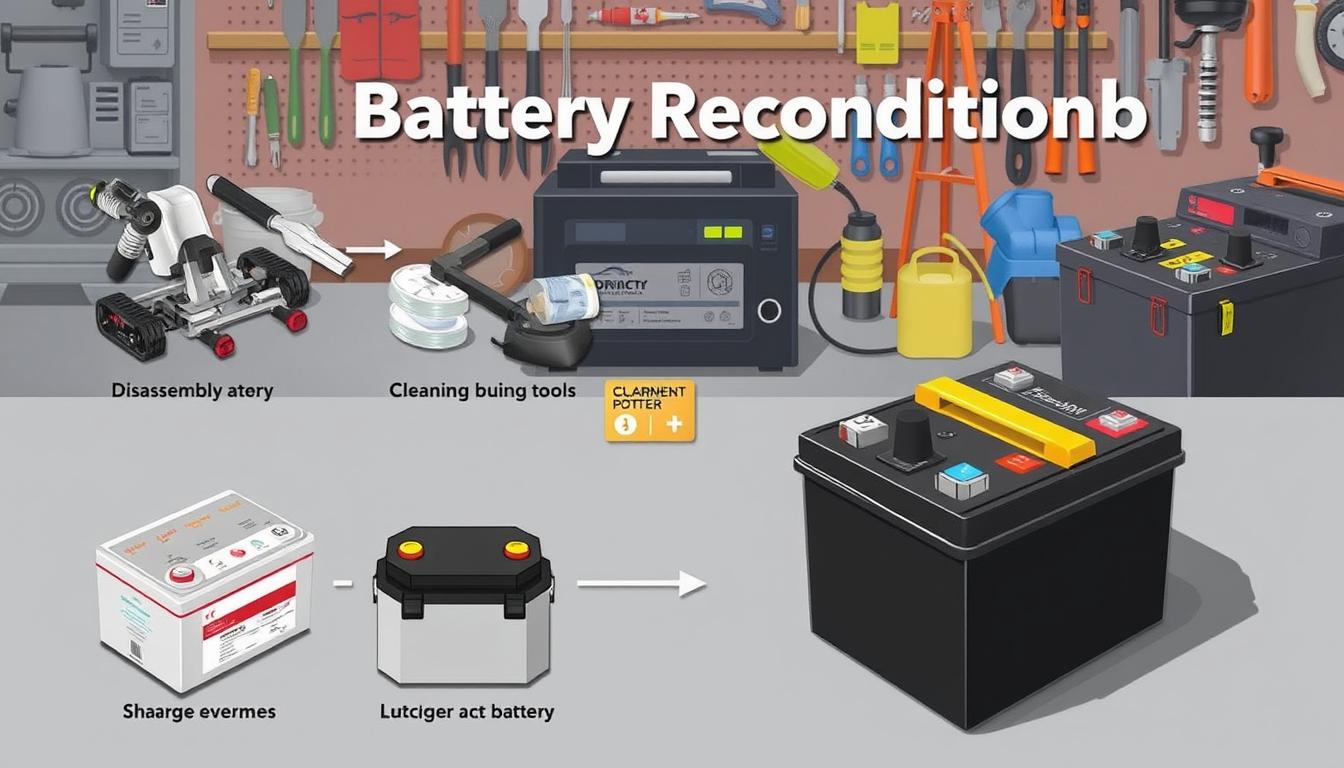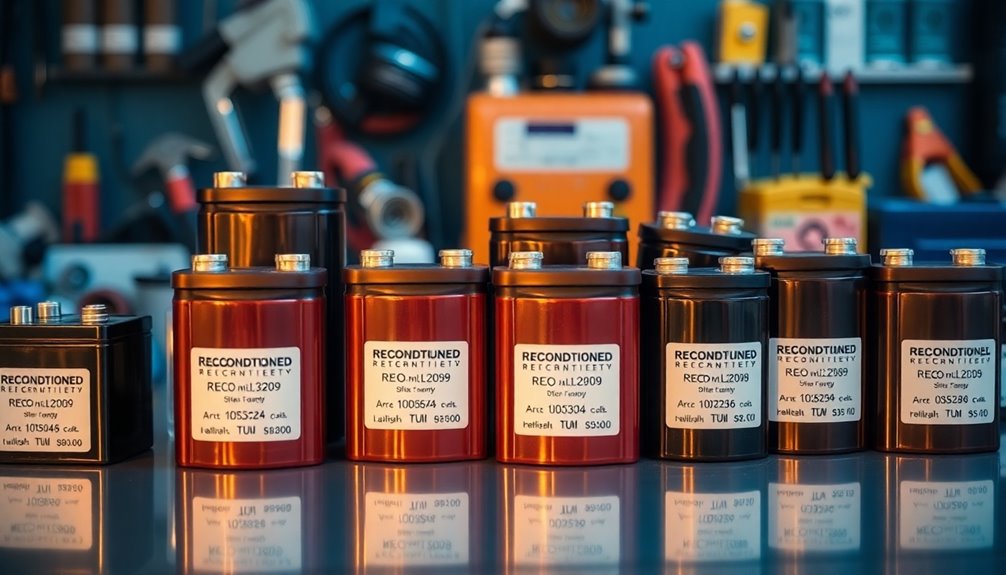Voltage thresholds are vital because they set safe charge and discharge limits during reconditioning. Staying within these limits prevents internal damage, capacity loss, and safety hazards. If you push beyond the recommended voltage, you risk weakening the battery’s structure and reducing its lifespan. Properly monitoring voltage guarantees you don’t overcharge or undercharge, boosting your chances of recovery. Keep these thresholds in mind, and you’ll improve your reconditioning success—more details to come if you keep exploring.
Key Takeaways
- Voltage thresholds set safe charge and discharge limits, preventing internal damage and increasing reconditioning success.
- Staying within voltage limits avoids capacity loss and extends the battery’s usable lifespan.
- Exceeding voltage thresholds can cause irreversible damage, reducing the likelihood of successful reconditioning.
- Proper voltage monitoring ensures batteries are reconditioned within safe parameters tailored to their chemistry.
- Maintaining appropriate voltage levels during reconditioning minimizes safety risks like overheating and enhances recovery rates.

Understanding voltage thresholds is essential for maximizing the success of battery reconditioning. When you’re working to restore a battery’s ideal performance, knowing the specific voltage levels at which a battery can be safely charged and discharged helps you avoid damaging it further. These thresholds act as critical boundaries that determine whether a battery can be revived or if it’s beyond repair. If you push a battery past its safe voltage limit, you risk deteriorating its internal structure, which reduces overall battery capacity and shortens the number of charge cycles it can go through in the future. Conversely, if you stay within the ideal voltage range, you give the battery a better chance to regain its original capacity and prolong its lifespan.
The concept of voltage thresholds directly impacts how many charge cycles your battery can endure post-reconditioning. A charge cycle refers to the process of charging a battery from empty to full and then discharging it back to empty. Every cycle causes some wear and tear, but staying within the recommended voltage thresholds minimizes this damage. If you overcharge or undercharge the battery, you accelerate capacity loss, meaning fewer usable charge cycles before the battery becomes unreliable or fails altogether. By precisely monitoring these voltage limits, you ensure that each charge cycle contributes to reconditioning rather than degrading the battery further. Properly managing these thresholds can also prevent overheating and other safety hazards during reconditioning.
To improve your success rate, you need to understand the ideal voltage levels for different types of batteries. Lithium-ion batteries, for example, typically have a maximum voltage of around 4.2 volts per cell, and exceeding this can cause permanent damage. Lead-acid batteries have different thresholds, often around 2.0 volts per cell during discharge. When reconditioning, use a multimeter or specialized charger to keep track of these voltages, ensuring you don’t push the battery beyond its safe limits. This careful approach helps restore the battery’s original capacity and extends its charge cycles, making each reconditioning effort more effective. Additionally, understanding battery chemistry can help you tailor your reconditioning practices for optimal results.
Frequently Asked Questions
How Do Temperature Variations Affect Voltage Threshold Accuracy?
Temperature variations impact voltage threshold accuracy through thermal effects, which can cause fluctuations in measurements. When temperatures change, calibration accuracy suffers because electronics expand or contract, altering their behavior. You need to account for these thermal effects to maintain precise voltage thresholds. By controlling or compensating for temperature variations, you guarantee reliable calibration accuracy, leading to more consistent and successful reconditioning outcomes.
Can Voltage Thresholds Predict Battery Lifespan After Reconditioning?
Think of voltage thresholds as the lighthouse guiding your ship—predicting battery lifespan after reconditioning. You can’t rely solely on them, but they help gauge voltage stability and capacity recovery. When thresholds stay consistent, your battery’s health likely improves, indicating a longer lifespan. However, if thresholds fluctuate, it suggests underlying issues. So, use voltage thresholds as a compass, not a crystal ball, to estimate how long your reconditioned battery will last.
Are There Industry Standards for Optimal Voltage Thresholds?
You want to know if industry standards for voltage thresholds exist. While there’s no universal standard, many industry leaders recommend specific voltage calibration procedures to guarantee consistency. These standards often vary based on battery type and application. By adhering to established voltage calibration practices, you can optimize reconditioning processes, improve battery performance, and ensure safety. Always consult manufacturer guidelines and industry best practices for accurate voltage threshold settings.
How Do Different Battery Chemistries Influence Threshold Settings?
You’re in the driver’s seat when it comes to how battery chemistry impacts threshold customization. Different chemistries, like lithium-ion or lead-acid, require tailored voltage thresholds to optimize reconditioning. You need to comprehend their unique characteristics; what works for one may not for another. Adjusting thresholds based on battery chemistry ensures you get the best performance. Remember, one size doesn’t fit all, so fine-tuning is key to success.
What Role Does Device Load Play During Voltage Measurement?
During voltage measurement, the device load markedly impacts measurement accuracy. When you apply a high load, it causes voltage drops that can misrepresent the battery’s true state, leading to inaccurate assessments. Conversely, a low or no load provides a clearer picture of the battery’s voltage, ensuring more precise readings. Understanding load impact helps you set correct thresholds, improving reconditioning success by avoiding false readings and better evaluating battery health.
Conclusion
By understanding voltage thresholds, you gain control over your reconditioning success. It’s a delicate balance—pushing too far risks damage, while staying within limits offers hope for renewal. The difference isn’t just technical; it’s emotional. You’re not just restoring a device, but rekindling trust in your efforts. With careful attention, you turn uncertainty into achievement, transforming doubt into confidence. In this journey, voltage thresholds become your guiding light through the challenge and the reward.










